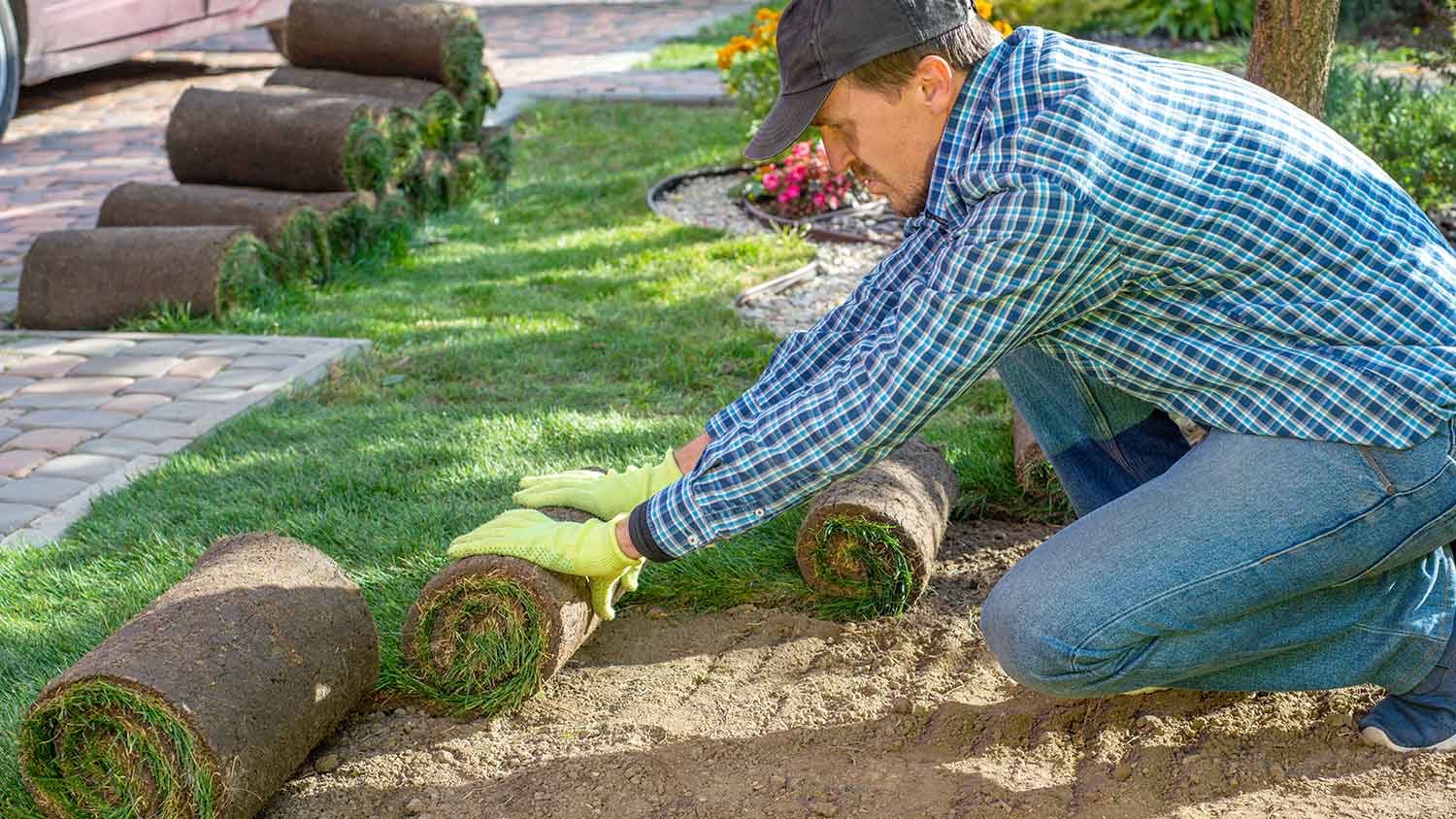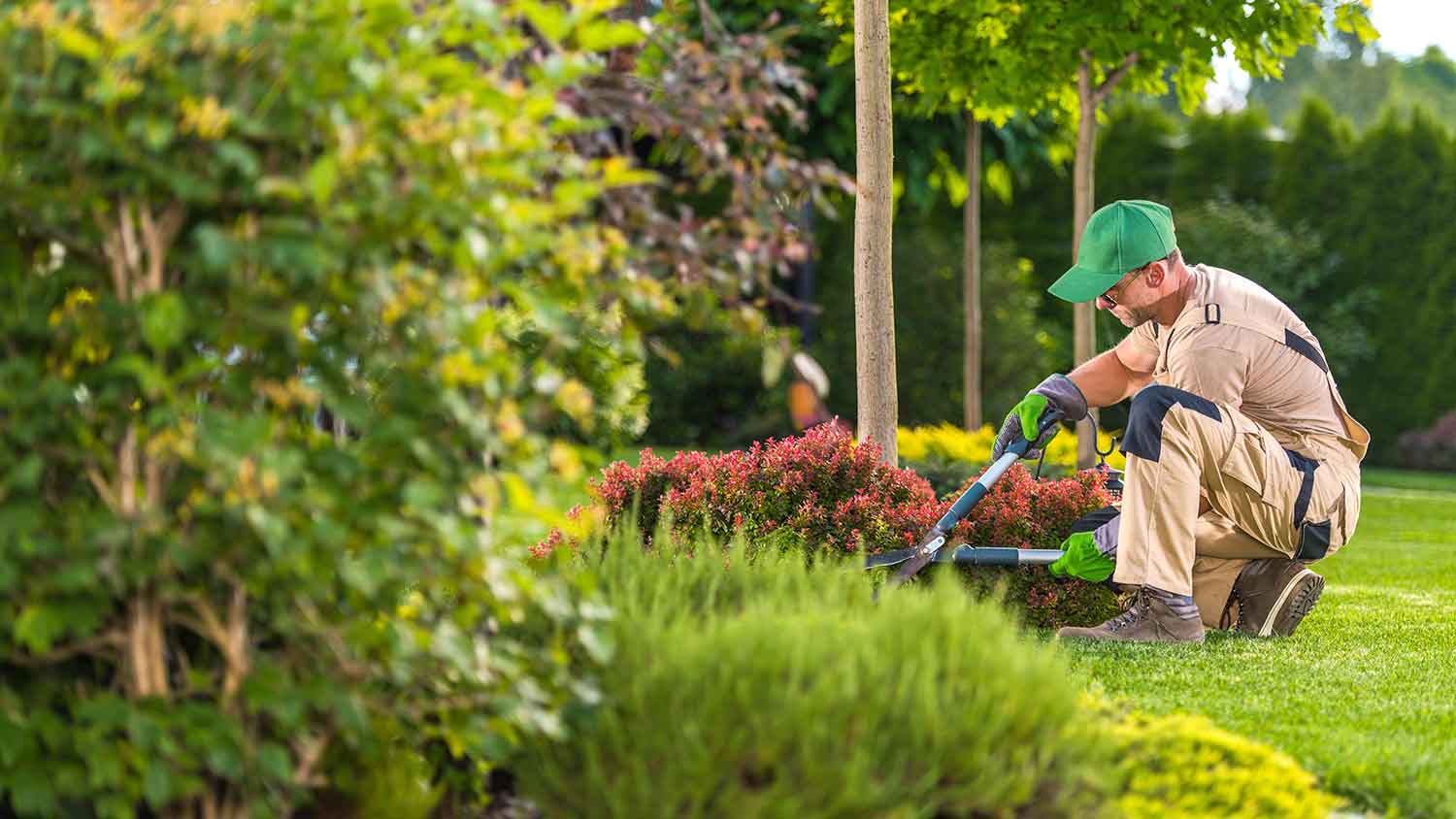
The cost to reseed a lawn can vary depending on the size of your yard and the condition of the soil. We’ll help you figure out the true cost of reseeding or overseeding your lawn, along with whether or not you should hire a professional.
The average U.S. homeowner spends $300 on lawn care costs. You can expect prices to range from $100 to $500 depending on lawn size and services.


Expect to pay as little as $100 per month for basic lawn care on 1/8 of an acre. Caring for larger outdoor spaces can cost as much as $3,200 per month for up to two acres.
Lawn care professionals charge an average of $35 to $70 per hour, with certain tasks costing as much as $190 per hour.
Common services like aerating and dethatching cost as much as $225 per service.
Installing new features to your lawn, like sod or flower beds, costs up to $3,000 per feature.
Lawn care costs $300 on average and can vary based on the types of service provided. However, you can expect to pay $100 to $500 for simple tasks like lawn mowing, fertilization, and leaf removal.
Regular lawn care is essential to keeping your lawn healthy and strong. Your total lawn care cost will depend on several factors, including the type of services, the size of your lawn, its current condition, and whether you hire a lawn care service. Learn more about the benefits of lawn care and how much you can expect to pay.
When figuring out how much your weekly, monthly, or annual lawn care will cost, you’ll need to consider several cost factors, such as the type of services, the size of your lawn, labor costs, prep, location, and grass type.
| Lawn Care Service Type | Average Cost |
|---|---|
| Lawn Mowing | $50–$205 |
| Landscaping | $1,260–$6,020 |
| Aeration | $75–$200 |
| Weed Removal | $35–$400 |
| Seeding | $440–$1,750 |
| Flower Bed Installation | $800–$3,000 |
| Hydroseeding | $500–$1,910 |
| Fertilizing | $71–$380 |
| Dethatching | $160–$225 |
| Sod Installation | $1,070–$3,000 |
| Sprinkler System Installation | $1,665–$3,550 |
| Drip Irrigation System Installation | $200–$850 |
| Lawn Winterization | $100–$400 |
| Leaf Removal | $300–$600 |
| Tree Trimming | $270–$1,800 |
| Shrub, Bush, and Hedge Trimming | $450–1,420 |
| Mulching | $30–$150 per cubic yard |
| Yard Cleanup | $190–$1,000 |
You can expect to pay $50 to $205 for lawn mowing service. Your overall cost will depend on the size of your lawn—with most lawn care companies charging $0.01 to $0.06 per square foot or $50 to $200 per acre. Other cost factors include:
Shape of your lawn
Type of grass
Condition of your lawn
Accessibility

You’ll pay anywhere from $1,260 to $6,020 in landscaping costs. Landscaping runs the gamut from flower bed installation to landscape lighting to a fountain installation. Your overall cost will depend on the scope of your project, yard size, the cost of materials, the type of landscaping, prep work, permits, and whether you’ll need to hire a professional landscape designer or architect.
You can expect to pay $75 to $200 for lawn aeration. This process allows vital nutrients, such as water and air, to nourish your lawn. A lawn aeration pro will poke hundreds of small holes in your yard to aerate your lawn, which helps it breathe. Your overall cost will depend on the size of your lawn and the type of aeration treatment you choose.
You’ll pay anywhere from $35 to $400 in weed removal service costs. Your total cost will depend on the size of your yard, the removal method, labor costs, accessibility, and lawn condition.
Great experience from start to finish. They responded to my inquiry quickly and came out to give me a quote the same day. My yard was overgrown with weeds and needed lots of trimming. The guys came out and pulled all of the weeds by hand to get them out by the roots and trimmed up nicely. They were able to come up with a treatment plan within my budget to get my lawn and yard looking great again. Very professional, efficient and knowledgeable.
Seeding and reseeding your lawn can cost between $440 and $1,750. Seeding provides vital nutrients to help your lawn grow healthy, strong, and green. Your overall seeding cost will depend on the size of your lawn, the type of seeds, and the seeding method.
You can expect to pay $800 to $3,000 for flower bed installation. For this lawn care service, a gardener will plant your favorite spring bulbs, pretty flowers, and native blooms. Pros know how to plant your flowers safely to survive the season.
You’ll pay $500 to $1,910 for lawn hydroseeding. Hydroseeding is spraying your lawn with grass seed, fertilizer, water, and mulch via a pressurized hose. This nutrient blast helps grow your lawn quickly in under a month. The amount you’ll pay depends on the size of your lawn.
Fertilizing your lawn will cost $70 to $380. Your overall lawn fertilization costs depend on the size of your yard, the type of fertilizer, and whether you add any additional lawn services.
You can expect to pay $160 to $225 to dethatch your lawn. Thatch is a mixture of plant matter, sticks, roots, and crowns that accumulate on top of your lawn, making it difficult for oxygen, water, and fertilizer to reach the roots. The cost to dethatch your lawn will depend on the size of your yard, the type of dethatching method, and the thickness of the thatch.

You’ll pay $1,070 to $3,000 for sod installation. Laying sod is much easier than planting seeds and waiting for the grass to grow. Your total cost will depend on your yard size, condition, and accessibility.
Installing a lawn sprinkler system will cost between $1,665 and $3,550. The overall cost will depend on the size of your lawn, the sprinkler system type, the number of sprinkler heads, and the number of zones.
You’ll pay $200 to $850 to install a drip irrigation system. Drip irrigation systems slowly and evenly deliver water at ground level to keep your lawn looking healthy and new. Your total cost will depend on the size of your lawn and the type of system you choose to install.
You can expect to pay $100 to $400 to winterize your lawn. Lawn winterization involves adding a new, tough fertilizer to your grass so it can withstand the harshness of winter. Your total cost will depend on the types of treatment your lawn needs to withstand the cold months.
You’ll pay $300 to $600 for leaf removal. Your total cost will depend on the size of your lawn, removal method, and the frequency of service needed.
You can expect to pay between $270 and $1,800 for tree trimming. Tree trimming helps keep your lawn free of branches and leaves. Your total cost depends on the size of the tree, type, health, accessibility, and the number of trees in your yard.
Bush trimming costs $450 to $1,420. The total cost will depend on the shrub, bush, or hedge type, amount, size, location, and debris cleanup and hauling.
You’ll pay $30 to $150 per cubic yard for mulch delivery and installation. Your total cost will depend on the materials used, the delivery method, labor, and the size of your garden beds.
Your yard cleanup cost could run between $190 and $1,000. Your total cost depends on the size of your yard, the type of services needed, the frequency of cleanups, and the season, with fall cleanup typically costing more than spring cleanup.
The size of your lawn plays a significant role in your total lawn care cost. The average lawn size is between ¼ and ⅕ of an acre or between 8,712 and 10,890 square feet. Here’s what you can expect to pay per month for lawn care:
| Lawn Size | Average Monthly Service Cost |
|---|---|
| ⅛ Acre | $100–$200 |
| ¼ Acre | $200–$400 |
| ½ Acre | $400–$800 |
| 1 Acre | $800–$1,600 |
| 2 Acres | $1,600–$3,200 |
Depending on the type of lawn care service you need, labor costs can range between $35 and $190 per hour, with the average ranging from $35 to $70 per hour. However, many lawn care professionals also structure their prices around the type of service provided. Be sure to ask your lawn care company about pricing per hour and per service.
A lawn care professional may need to do some prep work before caring for your lawn. For example, tree stump removal will cost $175 to $500. If a stump is blocking your yard and making lawn care difficult, you will likely need to remove it before a pro agrees to do yard work. Also, if your lawn is in poor condition, a pro will need to perform a lot of pre-maintenance before starting lawn care, so you’ll pay extra for that, too.
Your location plays a role in lawn care costs. Here are the average prices for lawn care in your area:
| Location | Average Cost Per Month |
|---|---|
| Atlanta, GA | $110–$450 |
| Boston, MA | $135–$550 |
| Chicago, IL | $115–$450 |
| Dallas, TX | $100–$425 |
| Honolulu, HI | $120–$500 |
| Houston, TX | $125–$500 |
| Los Angeles, CA | $110–$430 |
| Miami, FL | $100–$400 |
| Minneapolis, MN | $115–$450 |
| New York, NY | $130–$525 |
| Phoenix, AZ | $100–$400 |
| Seattle, WA | $110–$450 |

Depending on where you live, the grass might grow faster than in other locations. If that’s the case, you might need mowing more frequently, and you can expect your total cost to increase. On the flip side, some grasses grow slower and require less mowing.
| Grass Type | Mowing Frequency |
|---|---|
| Bahia | Weekly or Bimonthly |
| Bermuda | Weekly |
| Carpet | Bimonthly |
| Centipede | Weekly |
| Fescue | Bimonthly |
| Kentucky Bluegrass | Bimonthly |
| Ryegrass | Bimonthly |
| St. Augustine | Weekly |
| Zoysia | Weekly |

Most commonly, lawn care professionals charge a monthly fee for ongoing services or an hourly or per service charge for one-time visits. However, depending on the work needed, you can create a weekly, bi-weekly, seasonal, or yearly maintenance plan with a pro. However, your costs will be lower if you pay monthly or weekly rather than for a one-time service.
Regular lawn care also means you’ll need to budget for repairs. For example, the cost to repair your sprinkler system runs between $130 and $410, and gutter repairs cost $200 to $650.
If you had a harsh winter, you might need to have a lawn care pro seal and clean your pavers, and you can expect to pay $300 to $550 for this service.
You can save money on lawn care services by bundling projects into fewer visits. Consider whether your yard could benefit from the following professional tasks:
Flower bed installation: $800–$3,000
Sod installation: $1,070–$3,000
Sprinkler system installation: $1,665–$3,550
Drip irrigation system installation: $200–$850
Lawn care runs the gamut from mowing to sprinkler system installations. So, if you’re handy and enjoy getting your hands in the dirt, you can DIY several aspects of lawn care. You’ll save on monthly professional costs—$100 to $500. However, you’ll need to purchase your own equipment, which could be costly. You’ll need:
Lawn mower: $80–$3,200
String trimmer: $50–$400
Leaf blower: $50–$600
Weed control: $15–$40 per quart
Shed: $1,800–$18,000
Hedge clippers: $25–$50
Yet, lawn care is time-consuming. If you enjoy your free time and want your lawn to look immaculate, we recommend hiring a lawn care service near you. You can rest easy knowing that the lawn care pros have the knowledge, experience, and proper equipment to ensure your lawn looks fresh and healthy.
In addition to your regular lawn care schedule, you may want to add on extra services, including:
Watering plants: $35–$65 per hour
Tree planting: $150–$350
Pest control: $110–$260
Composting: $75–$225 per cubic yard
Gutter cleaning: $120–$230
Sprinkler system winterization: $60–$130
Snow removal: $40–$450
Soil testing: $680–$2,155
Although you can’t change the average costs of individual lawn care services, there are ways you can save, including:
Bundle your lawn care services in a weekly, bi-weekly, monthly, or yearly contract instead of paying one-time fees for each service.
Ask for a discount if you’re paying upfront for an annual contract.
Get quotes from at least three lawn care companies in your area before committing to a yearly contract.
Choose native plants that require less caretaking and watering.
Plant perennials instead of annuals, so you don’t need to plant new flowers each season.
Try to handle more manageable lawn care tasks yourself, such as mowing and watering, and leave the difficult projects to the pros.
Perform maintenance throughout the year so you won’t be stuck with a hefty bill for one-time cleaning and maintenance services.
Home is the most important place on earth, which is why Angi has helped more than 150 million homeowners transform their houses into homes they adore. To help homeowners with their next project, Angi provides readers with the most accurate cost data and upholds strict editorial standards. We extensively research project costs to develop the pricing data you see, so you can make the best decisions for you and your home. We rely on reputable sources, including the U.S. Bureau of Labor Statistics, academic journals, market studies, and interviews with industry experts—all to ensure our prices reflect real-world projects.
Want to help us improve our cost data? Send us a recent project quote to [email protected]. Quotes and personal information will not be shared publicly.
From average costs to expert advice, get all the answers you need to get your job done.

The cost to reseed a lawn can vary depending on the size of your yard and the condition of the soil. We’ll help you figure out the true cost of reseeding or overseeding your lawn, along with whether or not you should hire a professional.

The cost to renovate your lawn depends on the extent of the damage. Our guide will show you how much lawn renovation costs.

How much it costs to rent a lawn aerator depends on what kind you rent and how long you rent it for. Read on for the full details.

Learn how to grow grass fast to get the lush lawn of your dreams. From the best time to plant to choosing the right seed, here’s the quickest way to grow grass.

Orchard grass control can make you feel like you're going in circles. Here are all the ways to get rid of orchard grass with or without chemicals.

Straw is a popular mulching choice for newly planted grass. Should you put it down when planting grass? Find out the answer in this guide.